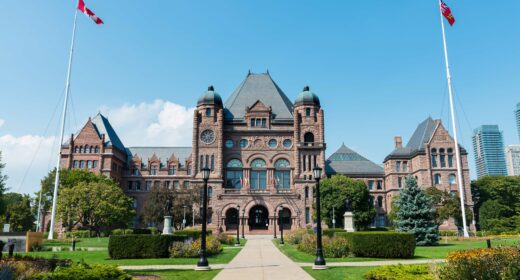In the case of Mounted Police Association of Ontario v. Canada (Attorney General), the Supreme Court of Canada, by a 6-1 majority, held that the s. 2(d) guarantee of freedom of association, as set out in the Canadian Charter of Rights and Freedoms (“Charter”), protects a meaningful process of collective bargaining that provides employees with a degree of choice and independence sufficient to enable them to determine and pursue their collective interests. The Court held that the current labour relations regime denies RCMP members that choice by imposing a scheme that does not permit them to identify and advance their workplace concerns free from management’s influence.
RCMP members have been historically excluded from the labour relations regime since collective bargaining was first introduced in the federal public service. Instead, because of s. 56 of the Royal Canadian Mounted Police Regulations, 2014, and its predecessor, they have always been subject to a non-unionized labour relations scheme. The core component of this scheme is the Staff Relations Representative Program (“SRRP”), imposed upon the RCMP by s. 96 of the Royal Canadian Mounted Police Regulations, 1988, since repealed (“RCMP Regulations”), which is the primary mechanism through which RCMP members can raise labour relations issues, and the only form of employee representation recognized by management. Even though the members’ representatives and management do consult, the final word always rests with management.
In May of 2006, a constitutional challenge was initiated by two private associations of RCMP members who sought a declaration that the combined effect of the exclusion of RCMP members from the application of the Public Service Labour Relations Act (“PSLRA”) and the imposition of the SRRP as a labour relations regime unjustifiably infringed the members’ freedom of association as recognized by s. 2(d) of the Charter.
The Ontario Superior Court of Justice concluded that s.96 of the RCMP Regulations substantially interfered with freedom of association because (i) the SRRP is not an independent association formed or chosen by members of the RCMP, and (ii) the interaction between the SRRP and management could not reasonably be described as a process of collective bargaining. The Court of Appeal reversed this decision.
The two main issues dealt with on appeal by the Supreme Court of Canada were the following:
(1) Does s. 96 of the RCMP Regulations infringe s. 2(d) of the Charter?
(2) Does paragraph (d) of the definition of “employee” at s. 2(1) of the PSLRA infringe s. 2(d) of the Charter?
Of course, should either infringement be found, the Court would then have to determine whether the infringement was a reasonable limit prescribed by law as can be demonstrably justified in a free and democratic society under s. 1 of the Charter.
The Supreme Court has previously held that s. 2(d) of the Charter confers the right to a process of collective bargaining, understood as meaningful association in pursuit of workplace goals. This process includes the employees’ rights to join together, to make collective representations to the employer and to have those representations considered in good faith. The Court maintains that s. 2(d) must be interpreted in a purposive and generous fashion.
However, as s. 2(d) of the Charter is aimed at reducing social imbalances, not enhancing them, some collective activity lies outside the Charter’s protection. Therefore, not all associational activities will be protected.
Overall, a purposive interpretation of s. 2(d) confers prima facie protection on a broad range of associational activity, including the following:
1. the right to join with others and form associations;
2. the right to join with others in the pursuit of other constitutional rights; and
3. the right to join with others to meet on more equal terms the power and strength of other groups or entities.
Based on the purposive approach, the Court concluded that s. 2(d) guarantees the right of employees to meaningfully associate in the pursuit of collective workplace goals, which includes a right to collective bargaining. The right to a meaningful process of collective bargaining is a necessary element of the right to collectively pursue workplace goals in a meaningful way. However, that right is one that guarantees a process rather than an outcome or access to a particular model of labour relations.
According to the Court, a “meaningful process of collective bargaining” is a process that provides employees with a degree of choice and independence sufficient to enable them to determine their collective interests and meaningfully pursue them.
With that said – government cannot enact laws or impose a labour relations process that substantially interferes with employees’ right to a meaningful process of collective bargaining.
The Court warns us however, that choice and independence are not absolute, but are limited by the context of collective bargaining. The degree of choice required by the Charter is “one that enables employees to have effective input into the selection of the collective goals to be advanced by their association”, whereas the degree of independence required by the Charter is “one that ensures that the activities of the association are aligned with the interests of its members”.
Examples of employee choice in the collective bargaining context include the ability to form and join new associations, to change representatives, to set and change collective workplace goals, and to dissolve existing associations.
Examples of independence include the freedom to amend the association’s constitution and rules, the freedom to elect the association’s representatives, control over financial administration and control over the activities the association chooses to pursue.
1. Does s. 96 of the RCMP Regulations, which Imposes the SRRP, Infringe s. 2(d) of the Charter?
The Supreme Court explained how this was not a case of a complete denial of the constitutional right to associate, and of its related constitutional guarantees, but rather a case of “substantial interference with the right to associate for the purpose of addressing workplace goals through a meaningful process of collective bargaining, free from employer control”.
The Supreme Court concluded that s. 96 of the RCMP Regulations, which imposed the SRRP as the sole recognized vehicle for engagement between RCMP membership and senior management, constituted a substantial interference with freedom of association in both purpose, described as a means to prevent RCMP members from forming independent associations for the purposes of collective bargaining, and effects, as these members would not be able to genuinely advance their own interests through the SRRP without interference from management. The Court did not consider the SRRP to be an association in any meaningful sense, and considered the element of employee choice to be almost entirely missing under the existing scheme.
As the SRRP process did not permit meaningful collective bargaining, it was deemed inconsistent with s. 2(d) of the Charter.
2. Does paragraph (d) of the definition of “employee” at s. 2(1) of the PSLRA infringe s. 2(d) of the Charter?
The PSLRA provides the general framework through which (i) federal public service employees can join and participate in employee associations, (ii) these associations can be certified as bargaining agents, and (iii) good faith collective bargaining can occur. Paragraph (d) of the definition of “employee” in s. 2(1) of the PSLRA excludes every person “who is a member or special constable of the Royal Canadian Mounted Police or who is employed by that force under terms and conditions substantially the same as those of one of its members”.
The Court considered whether the purpose behind the PSLRA exclusion infringed s. 2(d) of the Charter. This had to be assessed in relation to P.C. 1918-2213, the Order in Council that constituted the labour relations regime that applied to RCMP members at the time of PSLRA’s predecessor, the Public Service Staff Relations Act (“PSSRA”):
The exclusion of RCMP members from the PSSRA in 1967 – the only vehicle available for meaningful collective bargaining in the federal public service — was intended to prevent them from engaging in collective bargaining.
This is similarly true with the PSLRA which, once enacted, continued to exclude RCMP members in identical terms as under the PSSRA with no other statute permitting these members to engage in the process of collective bargaining.
Overall, the Court concluded that the purpose behind the PSLRA exclusion infringed s. 2(d) of the Charter:
The PSLRA exclusion is but a part of a constitutionally defective regime of labour relations, designed to prevent the exercise of the s. 2(d) rights of RCMP members.
3. Are the Limits Imposed on RCMP Members Justified Under Section 1 of the Charter?
The Supreme Court concluded that the limits could not be justified under s. 1 of the Charter. Even though it agreed that the need for an independent and objective police force constitutes a pressing and substantial objective under s. 1 of the Charter, it did not agree that the limits placed upon the RCMP members were rationally connected to the stated objective as it did not consider the measure as impairing the members’ s. 2(d) rights as little as possible in order to achieve the stated objective.
The Supreme Court decided to strike down the offending provision of the PSLRA, declaring paragraph (d) of the definition of “employee” in s. 2(1) ;of the PSLRA to be of no force or effect pursuant to s. 52 of the Constitution Act, 1982 as it infringed s. 2(d) of the Charter. It would have done the same for s. 96 of the RCMP Regulations had it not been repealed. This declaration of invalidity has been suspended for a period of 12 months.
For more information on this decision, visit our web page, ‘Supreme Court of Canada Backs RCMP Members’ Right to Collective Bargaining’.


